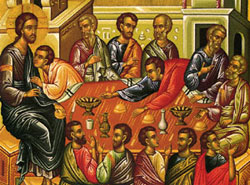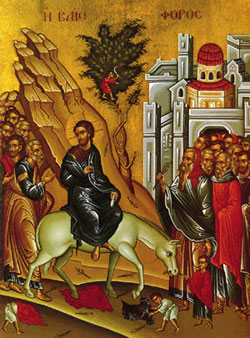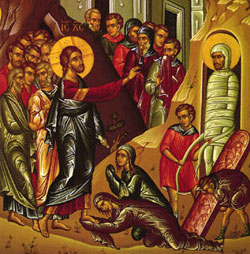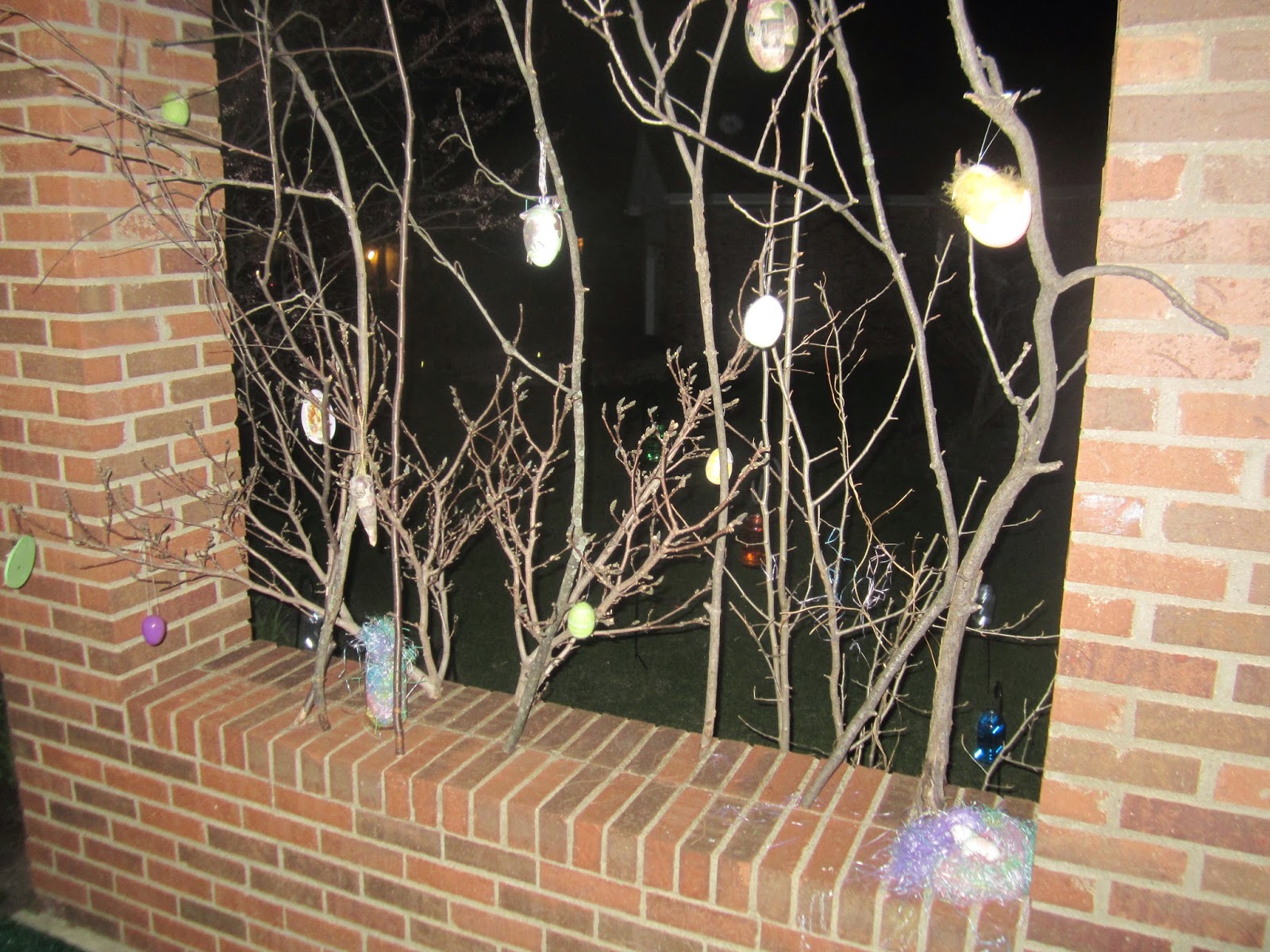Time flies doesn't it? We're only six months away from the sacred Fall trio: All Hallows Eve, All Saints Day, and All Souls Day. I prefer 'Triduum of All Hallows', but Hallowmas and Triduum of All Saints are common terms as well.
In a couple of days, I will be unveiling my decorating vision for the three holidays. Stay tuned.
Wednesday, April 30, 2014
Sunday, April 27, 2014
Divine Mercy Sunday
The second Sunday of Easter is called 'Divine Mercy Sunday' in the Roman Catholic Church. It is a very special day. Here's The Divine Mercy website for further info.
Interestingly, back in 2008, a leading Russian Orthodox Bishop, Hilarion Alfeyev, was invited to deliver a speech to the Catholic Church's first World Congress on Divine Mercy. In his speech, Bishop Alfeyev discussed St. Isaac of Syria's writings on the mercy of God. It's interesting because Isaac, a 7th century saint, was a Christian universalist who believed that Hell was limited in its duration and expressly for the purpose of cleansing, reforming, and restoring the sinner to God's good graces. As a Christian universalist, St. Isaac believed that through Christ's unfathomable mercy, all mankind would eventually be saved. While this is not the official view of the Roman Catholic Church, the Bishop's speech was still relatively well-received.
Ironically, if one closely evaluates many of the prayers associated with Divine Mercy, there is certainly a spirit of 'hopeful universalism' permeating them as Christ's redemptive sacrifice is repeatedly asked to mercifully extend to all of mankind.
Interestingly, back in 2008, a leading Russian Orthodox Bishop, Hilarion Alfeyev, was invited to deliver a speech to the Catholic Church's first World Congress on Divine Mercy. In his speech, Bishop Alfeyev discussed St. Isaac of Syria's writings on the mercy of God. It's interesting because Isaac, a 7th century saint, was a Christian universalist who believed that Hell was limited in its duration and expressly for the purpose of cleansing, reforming, and restoring the sinner to God's good graces. As a Christian universalist, St. Isaac believed that through Christ's unfathomable mercy, all mankind would eventually be saved. While this is not the official view of the Roman Catholic Church, the Bishop's speech was still relatively well-received.
Ironically, if one closely evaluates many of the prayers associated with Divine Mercy, there is certainly a spirit of 'hopeful universalism' permeating them as Christ's redemptive sacrifice is repeatedly asked to mercifully extend to all of mankind.
Sunday, April 20, 2014
Easter Sunday
"Where, O Death, is thy sting? Where, O Hades, is thy victory?" 1 Corinthians 15:55
"For as in Adam all die, so in Christ all will be made alive." 1 Corinthians 15:22
"Rise from the dead, for I am the life of the dead." Holy Saturday liturgical prayer
Following
up on my Good Friday post, there are three data which
reach the level of 'historical bedrock' concerning the end of Christ's
life. These three data are accepted by the vast majority (90% or more)
of New Testament scholars from all across the theological spectrum, i.e.
atheist, agnostic, moderate, liberal, and conservative. The first, as I
already shared, is Christ's death by crucifixion. The next two are as
follows:
- Very soon after Jesus died, His disciples had experiences that they believed were appearances of the resurrected Christ
-
A few years later, Saul of Tarsus (high-ranking Jewish religious leader
who zealously persecuted the early Christians before converting to
Christianity) also experienced what he thought was a post-resurrection
appearance of the risen Jesus
Now, obviously, this does not mean that all of these scholars accept the traditional Christian, philosophical interpretations derived from these data. It merely means that, independent of any particular theological paradigm, these data are considered to be well-established by the standard rules of historical scholarship.
Coincidentally,
while this particular datum does not quite rise to the level of
historical bedrock, the historicity of Christ's empty tomb is accepted
by 2/3 to 3/4 of all New Testament scholars.
To learn more, you can read this article published in the Southeastern Theological Review in 2012.
Saturday, April 19, 2014
Easter Eve: The Rabbit's Den
Here's what awaits Toddler Holidays upon waking up tomorrow morning:
A dozen plastic eggs with candy inside have been scattered about. Daytime pics to come tomorrow.
A dozen plastic eggs with candy inside have been scattered about. Daytime pics to come tomorrow.
Holy Saturday: Christ's Descent to Hell, aka The Harrowing of Hell
Holy
Saturday, the time between Christ's crucifixion and resurrection, is a
bit of a
theological mystery in Christianity. There are probably five main
views, which derive from scripture, the Apostles Creed, apocryphal
writings, and scholarly tradition:
1. Christ descended to Hell (or Hades, or the place of the dead, depending upon the particular translation) and preached His Gospel to both the righteous and unbelieving & wicked who had died before His advent. All were saved and entered heaven. This view is held by some in Eastern Orthodoxy.
2. Christ descended to Hell, preached His Gospel to both the righteous and unbelieving & wicked. Some repented and believed, others did not. This view is held by some in Eastern Orthodoxy as well.
3. Christ descended to Hell and retrieved only the 'Old Testament righteous', both Jewish and Gentile. This is the Roman Catholic view.
4. Christ descended to Hell simply to declare His victory over sin, death, and Satan. No one exited. This view is held by some in Protestant circles.
5. Christ's descent was strictly metaphorical, i.e. the 'descent' was merely an expression of his sacrificial death on the Cross. This view is held by some Protestants.
Personally, I hold to view #1. The following early church fathers strongly suggested or explicitly believed that Christ preached to and saved all of those in Hell during His descent:
1. Christ descended to Hell (or Hades, or the place of the dead, depending upon the particular translation) and preached His Gospel to both the righteous and unbelieving & wicked who had died before His advent. All were saved and entered heaven. This view is held by some in Eastern Orthodoxy.
2. Christ descended to Hell, preached His Gospel to both the righteous and unbelieving & wicked. Some repented and believed, others did not. This view is held by some in Eastern Orthodoxy as well.
3. Christ descended to Hell and retrieved only the 'Old Testament righteous', both Jewish and Gentile. This is the Roman Catholic view.
4. Christ descended to Hell simply to declare His victory over sin, death, and Satan. No one exited. This view is held by some in Protestant circles.
5. Christ's descent was strictly metaphorical, i.e. the 'descent' was merely an expression of his sacrificial death on the Cross. This view is held by some Protestants.
Personally, I hold to view #1. The following early church fathers strongly suggested or explicitly believed that Christ preached to and saved all of those in Hell during His descent:
- Athanasius of Alexandria, 4th century
- Gregory of Nazianzus, 4th century
- Gregory of Nazianzus, 4th century
- John Chrysostom, 4th century
- Jerome, 5th century
- Cyril of Alexandria, 5th century- Jerome, 5th century
This 4th century Holy Saturday liturgical prayer also seems to suggest that the impact of Christ's descent was universal in nature, extending to all of departed humanity at the time.
And the way I see it, if Christ truly harrowed Hell once before, then He can certainly do it again at the end of time.
Friday, April 18, 2014
Good Friday
"And when I am lifted up from the earth, I will draw all people to myself." John
12:32
"...because we trust in the living God, who is the Savior of all men, especially of those who believe." 1 Timothy 4:10
"And He Himself is the propitiation for our sins, and not for ours only but also for the whole world." 1 John 2:2
"...because we trust in the living God, who is the Savior of all men, especially of those who believe." 1 Timothy 4:10
"And He Himself is the propitiation for our sins, and not for ours only but also for the whole world." 1 John 2:2
Interesting
factoids: In addition to early Christian testimony, Christ's death by
crucifixion is explicitly confirmed by the following primary sources:
- Tacitus, 1st/2nd century Roman historian
- Josephus, 1st century Jewish
historian
- Sanhedrin 43a in the Talmud (70-200 AD period)
- Lucian, 2nd century Greek satirist
Tacitus and Josephus specified that Christ was crucified under the Roman Procurator Pontius Pilate.
Tacitus and Josephus specified that Christ was crucified under the Roman Procurator Pontius Pilate.
Finally, in historical Jesus research, Christ's death by crucifixion is considered one of three historical data that reaches the level of 'historical bedrock', i.e. its historicity is accepted by the vast majority of New Testament scholars, which includes atheist, agnostic, and 'liberal' scholars. The other two historical data will be unveiled on Easter Sunday.
Thursday, April 17, 2014
Maundy Thursday
From the Byzantine Catholic Church in America:
 Matthew 26:26-29
- Now as they were eating, Jesus took bread, and after blessing it
broke it and gave it to the disciples, and said, "Take, eat; this is my
body." And he took a cup, and when he had given thanks he gave it to
them, saying, "Drink of it, all of you, for this is my blood of the new
covenant, which is poured out for many for the forgiveness of sins. I
tell you I will not drink again of this fruit of the vine until that day
when I drink it new with you in my Father's kingdom." (RSV)
Matthew 26:26-29
- Now as they were eating, Jesus took bread, and after blessing it
broke it and gave it to the disciples, and said, "Take, eat; this is my
body." And he took a cup, and when he had given thanks he gave it to
them, saying, "Drink of it, all of you, for this is my blood of the new
covenant, which is poured out for many for the forgiveness of sins. I
tell you I will not drink again of this fruit of the vine until that day
when I drink it new with you in my Father's kingdom." (RSV)
Scripture
Great and Holy Thursday
April 17, 2014
The Hour Has Come - At every celebration of the
Eucharist we participate in the events of Holy Thursday – the Mystical
Supper and all that followed: the agony in the Garden at Gethsemane, the betrayal by Judas, the arrest, Jesus before Caiaphas, and Peter’s denial. Jesus does not flee from what is to come and what must come. "Now
is my soul troubled. And what shall I say? 'Father, save me from this
hour'? But for this purpose I have come to this hour” (John 12:27).
The agony in the Garden anticipates the agony on the Cross by which the
world is saved. Whenever and wherever the Mystery of the Eucharist is
celebrated we are present with Christ at that place and at that time.
Today we also continue the readings from Exodus (the Passion, Death and
Resurrection of our Lord prefigured in the journey of the Israelites
from slavery in Egypt into the Promised Land) and Job (his tenacious
faith in God).Scripture
- Matins - Luke 22:1-39
- Hours - Jeremiah 11:18-12:5,9-11,14-15
- Vespers and Divine Liturgy of St. Basil the Great - Exodus 19:10-19, Job 38:1-21; 42:1-5; Isaiah 50:4-11, Matthew 26:2-20, John 13:3-17, Matthew 26:21-39, Luke 22:43-45; Matthew 26:40-27:1 (Composite)
Sunday, April 13, 2014
Palm Sunday
From the Byzantine Catholic Church in America:
Entry of our Lord, God, and Savior Jesus Christ into Jerusalem
 John 11:1-18 - Six days before the Passover, Jesus came to Bethany, where Laz'arus was, whom Jesus had raised from the dead. There they made him a supper; Martha served, and Laz'arus
was one of those at table with him. Mary took a pound of costly
ointment of pure nard and anointed the feet of Jesus and wiped his feet
with her hair; and the house was filled with the fragrance of the
ointment. But Judas Iscariot, one of his disciples (he who was to betray him), said, "Why was this ointment not sold for three hundred denarii
and given to the poor?" This he said, not that he cared for the poor
but because he was a thief, and as he had the money box he used to take
what was put into it. Jesus said, "Let her alone, let her keep it for
the day of my burial. The poor you always have with you, but you do not
always have me."
John 11:1-18 - Six days before the Passover, Jesus came to Bethany, where Laz'arus was, whom Jesus had raised from the dead. There they made him a supper; Martha served, and Laz'arus
was one of those at table with him. Mary took a pound of costly
ointment of pure nard and anointed the feet of Jesus and wiped his feet
with her hair; and the house was filled with the fragrance of the
ointment. But Judas Iscariot, one of his disciples (he who was to betray him), said, "Why was this ointment not sold for three hundred denarii
and given to the poor?" This he said, not that he cared for the poor
but because he was a thief, and as he had the money box he used to take
what was put into it. Jesus said, "Let her alone, let her keep it for
the day of my burial. The poor you always have with you, but you do not
always have me."
Entry of our Lord, God, and Savior Jesus Christ into Jerusalem
When the great crowd of the Jews learned that he was there, they came, not only on account of Jesus but also to see Laz'arus, whom he had raised from the dead. So the chief priests planned to put Laz'arus also to death, because on account of him many of the Jews were going away and believing in Jesus.
The next day a great crowd who had come to the feast heard that Jesus
was coming to Jerusalem. So they took branches of palm trees and went
out to meet him, crying, "Hosanna! Blessed is he who comes in the name
of the Lord, even the King of Israel!" And Jesus found a
young ass and sat upon it; as it is written, "Fear not, daughter of
Zion; behold, your king is coming, sitting on an ass's colt!" His
disciples did not understand this at first; but when Jesus was
glorified, then they remembered that this had been written of him and
had been done to him. The crowd that had been with him when he called Laz'arus
out of the tomb and raised him from the dead bore witness. The reason
why the crowd went to meet him was that they heard he had done this
sign.
Hosanna! Save us Now! – Is this the crowd who would
applaud His crucifixion? How was their hatred earned from his grace?
Even the words of their commendation pointed to the power of redemption.
“Hosanna” in Hebrew signifies the redemption of the house of David.
They are calling upon the Son of David. They are celebrating the
inheritance of the eternal kingdom. They are proclaiming the blessing in
the name of the Lord. Soon their shouting of “Crucify Him!” would be
blasphemy. But at present, the deeds he was doing there were exhibiting
the form of the future. It is granted that the crowd was doing these
things with very confused emotions. The things that would follow would
be different. Nevertheless they were, inadvertently and without willing
it, pointing to heavenly things unfolding. In this way the whole city of
Jerusalem was stirred.
Scripture
- Vespers - Genesis 49:1-2,8-12, Zephaniah 3:14-19, Zechariah 9:9-15
- Matins - Mathew 21:1-11, 15-17
- Divine Liturgy - Phillipians 4:4-9 , John12:1-18
Saturday, April 12, 2014
Holy Week Begins
In Eastern Christianity, Holy Week starts today with 'Lazarus Saturday'. From the Byzantine Catholic Church in America:
Lazarus Saturday
Great and Holy Week
 It is the voice of the Lord, the proclamation of the King – an authoritative command.
It is the voice of the Lord, the proclamation of the King – an authoritative command.
Lazarus Saturday
Great and Holy Week
Come out! Leave corruption behind and receive the flesh of incorruption.
Lazarus, Come out! Let them know that the time has come when those in
the tombs will hear the voice of the Son of man. Once they have heard
they will come alive.
Come out! The stumbling block is taken away. Come to me – I am calling you.
Come out! Covered with the burial cloth so that they won’t think you
were only pretending to be dead. Let them see your hands and feet bound
and your face covered. Let them see if they still do not believe the
miracle.
Come out! Let the stench of your body prove the resurrection. Let the
burial linen be undone so that they can recognize the one who was put in
the tomb.
Come out! Come alive and be alive! Come out of the tomb. Teach them how
all creation will be enlivened in a moment when the trumpet’s voice
proclaims the resurrection of the dead.
Come out! Leave behind the burial cloth and glorify the miracle. Leave
the revolting stench of death and proclaim the strength of my power.
Come out! I, who said, “Let there be light, let there be firmament.”
St. Andrew of Crete, Homily 8 on Lazarus
Scripture
- Divine Liturgy - Hebrews 12:28-13:8, John 11:1-45
Tuesday, April 1, 2014
Easter Season Has Arrived
Easter schedule:
Sunday, April 13- Palm Sunday
Thursday, April 17- Maundy Thursday
Friday, April 18- Good Friday
Saturday, April 19- Holy Saturday, Set up front porch Easter display after Toddler Holidays goes to bed
Sunday, April 20- Resurrection Sunday, Toddler Holidays Easter egg hunt
Also, Halloween season begins in 6 months! I will unveil this year's yard haunt theme at the end of the month.
Sunday, April 13- Palm Sunday
Thursday, April 17- Maundy Thursday
Friday, April 18- Good Friday
Saturday, April 19- Holy Saturday, Set up front porch Easter display after Toddler Holidays goes to bed
Sunday, April 20- Resurrection Sunday, Toddler Holidays Easter egg hunt
Also, Halloween season begins in 6 months! I will unveil this year's yard haunt theme at the end of the month.
Subscribe to:
Posts (Atom)




















